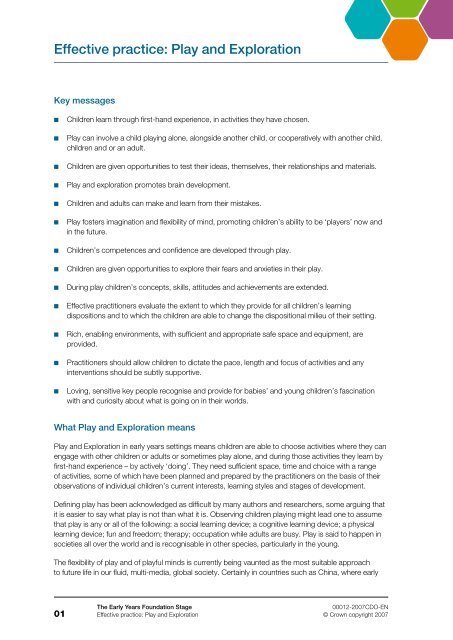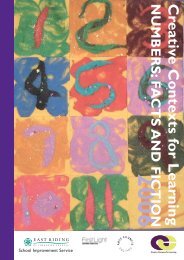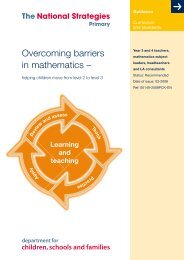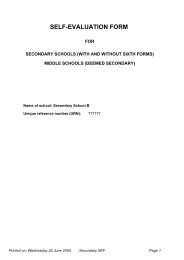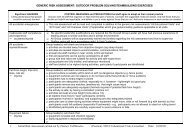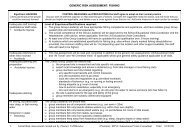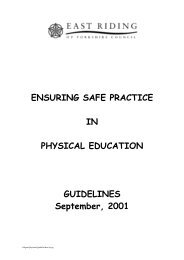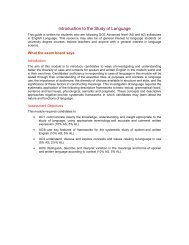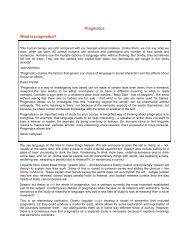Effective practice: Play and Exploration
Effective practice: Play and Exploration
Effective practice: Play and Exploration
You also want an ePaper? Increase the reach of your titles
YUMPU automatically turns print PDFs into web optimized ePapers that Google loves.
childhood education <strong>and</strong> care has traditionally been quite didactic <strong>and</strong> formal, there is much interest inthe education of young children through play (David <strong>and</strong> Powell, 2005). Knowing how to be a ‘player’may be an important attribute <strong>and</strong> one that children can acquire only through experience. <strong>Play</strong> is ameans of dealing with problems <strong>and</strong> of gaining control over one’s life. It helps people of any age to beproactive <strong>and</strong> dynamic, autonomous learners rather than people to whom life happens (Moyles, 2005).<strong>Play</strong> helps young children to be competent learners who can make connections <strong>and</strong> who can create<strong>and</strong> transform ideas <strong>and</strong> knowledge, because they are imaginative <strong>and</strong> expressive.Bruce (2001) suggests that free-flow play is coordinated, moves fluidly from one phase or scenario tothe next <strong>and</strong> makes young children feel powerful <strong>and</strong> contented. She emphasises that:‘Children at play are able to stay flexible, respond to events <strong>and</strong> changing situations, be sensitive topeople, to adapt, think on their feet, <strong>and</strong> keep altering what they do in a fast-moving scene. When theprocess of play is rich, it can lead children into creating rich products in their stories, paintings, dances,music making, drawings, sculptures <strong>and</strong> constructions, or in the solving of scientific <strong>and</strong> mathematicalproblems.’(Bruce, 2001, p.46)In free-flow play children:■■■■■■■■■■■use first-h<strong>and</strong> experiences from life;make up rules as they play in order to keep control;symbolically represent as they play, making <strong>and</strong> adapting play props;choose to play – they cannot be made to play;pretend;sometimes play alone;play with adults <strong>and</strong> other children, cooperatively in pairs or groups;have individual play agenda, which may or may not be shared;are deeply involved <strong>and</strong> difficult to distract from their deep learning as they wallow in their play <strong>and</strong> learning;try out their most recently acquired skills <strong>and</strong> competences, as if celebrating what they know;coordinate ideas <strong>and</strong> feelings, <strong>and</strong> make sense of relationships with their families, friends, cultures.(Adapted from Bruce, 2004, p.132)<strong>Play</strong> also has the advantages that a child can move in <strong>and</strong> out of the play <strong>and</strong> they can pick up playnarratives where they left off. They can recall <strong>and</strong> repeat earlier play bouts <strong>and</strong> this provides a startingpoint for ease in their next encounter with a familiar playmate, for example, another child, an oldersibling or a gr<strong>and</strong>parent. <strong>Play</strong> is also multi-layered. Children build on their earliest experiences, <strong>and</strong>often at the heart of the very complex play bouts of older children, one can glimpse the contributions ofearlier encounters.During play children may begin by exploring <strong>and</strong> experimenting with what interests them by lookingabout, listening to <strong>and</strong> taking in the smells of their home or early years setting, observing what goes onthere <strong>and</strong> how the people in it behave. They may touch objects, move around the spaces, manipulateThe Early Years Foundation Stage00012-2007CDO-EN<strong>Effective</strong> <strong>practice</strong>: <strong>Play</strong> <strong>and</strong> <strong>Exploration</strong> © Crown copyright 2007 02
■■■■■■■■■■■■■■■■practising skills <strong>and</strong> learning new ones;exercising, developing <strong>and</strong> coordinating body, mind <strong>and</strong> brain;adapting or transforming knowledge, attitudes <strong>and</strong> skills;negotiating;following an interest or line of enquiry;engaging in ‘What if?’ activity;making up rules <strong>and</strong> changing them;making mistakes;demonstrating one’s competence in many areas of development;setting one’s own goals;trying to emulate someone else;using symbols;making sense of puzzling situations, events or equipment;becoming <strong>and</strong> being confident <strong>and</strong> enjoying challenges;having fun with friends <strong>and</strong>/or familiar adults;learning how to be a ‘player’ fit for life in a high-tech, post-industrial society.<strong>Effective</strong> <strong>practice</strong> in relation to <strong>Play</strong> <strong>and</strong> <strong>Exploration</strong>Learning through experienceChildren engaged in play <strong>and</strong> exploration are learning through experience, because young children’sdevelopment <strong>and</strong> learning, whether physical, social, emotional, moral or cognitive, requires real, h<strong>and</strong>sonengagement – it cannot be done by means of a worksheet. In play, children can express theirfears <strong>and</strong> re-live anxious experiences in controlled <strong>and</strong> safe situations. They can take risks <strong>and</strong> makemistakes, try things out <strong>and</strong> make sense of relationships.Early years settings which effectively promote children’s learning through play ensure that they offera suitable, safe context for learning which includes a range of appropriate resources. There will beclear rules, discussed with the children, about how to access those resources, <strong>and</strong> encouragement toshare <strong>and</strong> take care of them. Some settings will have limited storage space or finances, but children’simaginations are fired by simple resources which cost very little: dens made from old curtains (offeringdifferent textures, patterns, light penetration); large cardboard boxes (which can be painted or havedoors <strong>and</strong> windows cut); catalogues (for example, from travel agents that, together with a couple of toytelephones <strong>and</strong> some stationery, can transform tables <strong>and</strong> chairs into a travel shop). Role-play areas,equipped with some items of dressing-up clothes <strong>and</strong> other easily obtainable materials, allow childrento take on <strong>and</strong> rehearse new <strong>and</strong> familiar roles.Each child comes to an early years setting as an individual with a unique cultural background <strong>and</strong> rangeof experiences. Children’s initial choice among play activities is likely to be influenced by those familiarThe Early Years Foundation Stage00012-2007CDO-EN<strong>Effective</strong> <strong>practice</strong>: <strong>Play</strong> <strong>and</strong> <strong>Exploration</strong> © Crown copyright 2007 04
Children need time to explore resources <strong>and</strong> equipment (engage in epistemic play) before practitionerschallenge them to use the resources to solve a particular problem. The experience gained helps themto feel familiar with the resources <strong>and</strong> thus to be more likely to solve the problem successfully. Duringtheir interventions practitioners can develop children’s language <strong>and</strong> extend their ideas. Sometimesthis will require the practitioner to remind the children how they solved a similar problem before, orhint at other useful resources, encouraging them to be conscious of previous learning, knowledge <strong>and</strong>thinking. These processes are called ‘metacognition’.Additionally, effective practitioners can learn a great deal about children’s developing thought processesby working closely with parents <strong>and</strong> enabling them to underst<strong>and</strong> children’s actions during play, whichindicate they are working on certain ‘schemas’ (Athey, 1990; Nutbrown, 2006) or developmentalpatterns. They can then provide appropriate play equipment <strong>and</strong> tune in to the child’s fascination.<strong>Effective</strong> practitioners evaluate the range <strong>and</strong> purposes of the play activities they provide <strong>and</strong> howdifferent children are involved in them. They reflect on whether all the children engage in activitiesintended to foster learning in all areas of development <strong>and</strong> may suggest to colleagues (in a groupsetting) that certain children need extra encouragement to try particular equipment or tasks.<strong>Play</strong> can enable children to have a voice (Duffy, 2005), as long as the adults are sensitive to ways inwhich certain children could be being silenced by a free play regime. It has been argued that playis used by some societies to prepare children for life in particular contexts <strong>and</strong> to foster conformity.Research has shown that this criticism can be true. Practitioners need to be aware of the possiblemisuse of play (Brooker, 2005), <strong>and</strong> should observe, reflect <strong>and</strong> act on their insights. It is important they intervene in play if it is racist, sexist or in any other way offensive, unsafe, violent or bullying.Contexts for learningChildren do not separate their experiences into play <strong>and</strong> learning since they learn as they play <strong>and</strong> canhave fun while they learn; there are therefore many contexts for children’s learning. Recognising thatdifferent contexts encourage different types of play <strong>and</strong> exploration is a key factor in providing suitableexperiences to support both children’s transient <strong>and</strong> long-term interests.Sometimes children may be inspired for a short time after hearing an ambulance, police or fire enginesiren, to explore sound <strong>and</strong> movement, or to look for resources, such as walkie-talkies or helmets totake on the roles of these professions.At other times children may have long-term interests in things such as machinery seen daily on theirway to the setting, or in building structures or in caring for a baby or pet. When children show suchlong-term interests practitioners can capitalise on the opportunities offered by inspiring children’sinvestigations, providing further ideas or resources <strong>and</strong> recognising that children need time to exploreat their own speed. For some children this may be for a whole week, perhaps finding out about howthings move when banged, or beaten, while for others, interested in mini-beasts, for example, it may befor much longer, becoming a lasting focus of their interest.Not all children will express a strong interest in exploring a particular thing <strong>and</strong> some will benefit frombeing encouraged by adults. Where this is the case it is important both to build on routine activities<strong>and</strong> to capitalise on new experiences. This may include talking to children, looking at books or readingstories about the focus, finding a particular resource or supporting their interest in some other way,such as arranging a visit. It is also important to challenge stereotypes so that children learn that in theirplay <strong>and</strong> exploration there are no barriers to the many possibilities that arise.The Early Years Foundation Stage00012-2007CDO-EN<strong>Effective</strong> <strong>practice</strong>: <strong>Play</strong> <strong>and</strong> <strong>Exploration</strong> © Crown copyright 2007 06
Dispositions for learningFurthermore, drawing on Margaret Carr’s (2001) work in New Zeal<strong>and</strong>, we can use the idea of learningdispositions to underst<strong>and</strong> what makes a baby or young child’s access to the learning experiences inan early years setting easy or difficult for them. Practitioners who recognise <strong>and</strong> value what <strong>and</strong> howchildren learn at home will help them underst<strong>and</strong> the ways in which they may be creating barriers tolearning for some children. This was particularly obvious in a research project (Tizard <strong>and</strong> Hughes, 1984)that discovered that boys from socio-economically disadvantaged homes made little progress becausethey spent a lot of time on the wheeled outdoor equipment at their nurseries. This was their activity ofchoice but as staff merely monitored outdoor play <strong>and</strong> did not engage with any of the children, the boysdid not move on in their learning, nor widen the areas of development in which they engaged.Carr proposes five domains of learning dispositions:■■■■■taking an interest;being involved;persisting with difficulty or uncertainty;communicating with others;taking responsibility.She then analyses the domains as three parts: being ready; being willing; <strong>and</strong> being able.Similarly, work in Belgium (Laevers, 1994) <strong>and</strong> in the UK (Pascal et al., 1995) describes involvement<strong>and</strong> well-being as central processes in learning. Deep involvement <strong>and</strong> becoming ‘lost’ in an activitywhich has its own rewards links free-flow play to the idea of dispositions.Each early years setting is a dispositional milieu: a place that presents children with particular views ofwhat it means to learn <strong>and</strong> be a learner. Children will fit in <strong>and</strong> thrive in a milieu, or they may avoid, resistor try to change that milieu. The type of learners children become will be influenced by the environment.<strong>Effective</strong> dispositional milieu are said to be characterised by challenging activities that inviteinvolvement, provision for children to make choices <strong>and</strong> share responsibility – meaning the children arepowerful, competent members of a learning community of players who share ideas <strong>and</strong> roles. Further,effective dispositional milieu celebrates diversity, <strong>and</strong> values different cultural approaches to play. Thepractitioners are flexible <strong>and</strong> go with the flow of the children’s play, delighting in spontaneity but stillable to recognise <strong>and</strong> reflect on what the children have achieved.ReferencesAthey, C. (1990) Extending Thought in Young Children: a parent–teacher partnership, Paul ChapmanPublishing, London.Brooker, L. (2005) ‘Learning to be a child: cultural diversity <strong>and</strong> early years ideology’ in Yell<strong>and</strong>, N. (ed.)Critical Issues in Early Childhood Education, Open University Press, Maidenhead.Bruce, T. (2001) Learning Through <strong>Play</strong>: babies, toddlers <strong>and</strong> the foundation years, Hodder &Stoughton, London.Bruce, T. (2004) ‘<strong>Play</strong> matters’ in Abbott, L. <strong>and</strong> Langston, A. (eds) Birth to Three Matters: supportingthe framework of effective <strong>practice</strong>, Open University Press, Maidenhead.07The Early Years Foundation Stage00012-2007CDO-EN<strong>Effective</strong> <strong>practice</strong>: <strong>Play</strong> <strong>and</strong> <strong>Exploration</strong> © Crown copyright 2007
Carr, M. (2001) Assessment in Early Childhood Settings: learning stories, Paul Chapman Publishing, London.David, T. (1996) ‘Their right to play’ in Nutbrown, C. (ed.) Respectful Educators, Capable Learners:children’s rights <strong>and</strong> early education, Paul Chapman Publishing, London.David, T. <strong>and</strong> Powell, S. (2005) ‘<strong>Play</strong> in the early years: the influence of cultural difference’ in Moyles, J.(ed.) The Excellence of <strong>Play</strong>, Open University Press, Maidenhead.Duffy, B. (2005) ‘Art in the early years’ in Moyles, J. (ed.) The Excellence of <strong>Play</strong>, Open University Press,Maidenhead.Edwards, C.P., G<strong>and</strong>ini, L. <strong>and</strong> Forman, G. (1998) The Hundred Languages of Children: the ReggioEmilia approach – advanced reflections, Ablex Publishing Corporation, New York.Gopnik, A., Meltzoff, A., <strong>and</strong> Kuhl, P. (1999) How Babies Think: the science of childhood, Weidenfeld &Nicolson, London.Hutt, S.J., Tyler, S., Hutt, C. <strong>and</strong> Christopherson, H. (1989) <strong>Play</strong>, <strong>Exploration</strong> <strong>and</strong> Learning: a naturalhistory of the pre-school, Routledge, London.Laevers, F. (1994) The Leuven Involvement Scale for Young Children, Centre for Experiential Education,Leuven, Belgium.Meek, M. (1985) ‘<strong>Play</strong> <strong>and</strong> paradoxes’ in Wells, G. <strong>and</strong> Nicholls, J. (eds) Language <strong>and</strong> Learning: aninternational perspective, Falmer Press, London.Moyles, J. (ed.) (2005) The Excellence of <strong>Play</strong>, Open University Press, Maidenhead.Nutbrown, C. (2006) Threads of Thinking: young children learning <strong>and</strong> the role of early education, PaulChapman Publishing, London.Pascal, C., Bertram, A., Ramsden, F., Georgeson, J., Saunders, M. <strong>and</strong> Mould, C. (1995) Evaluating<strong>and</strong> Developing Quality in Early Childhood Settings: a professional development programme,Worcester College of Higher Education, Worcester.Sylva, K., Melhuish, E., Sammons, P., Siraj-Blatchford, I., Taggart, B. <strong>and</strong> Elliot, K. (2003) The <strong>Effective</strong>Provision of Pre-school Education (EPPE) Project: findings from the pre-school period, Institute ofEducation, London.Tizard, B. <strong>and</strong> Hughes, M. (1984) Young Children Learning: talking <strong>and</strong> thinking at home <strong>and</strong> at school,Fontana Press, London.Vygotsky, L. (1978) Mind in Society: the development of higher psychological processes, HarvardUniversity Press, London.Further resourcesBroadhead, P. (2004) Early Years <strong>Play</strong> <strong>and</strong> Learning: developing social skills <strong>and</strong> cooperation,Routledge Falmer, London.Edgington, M. (2004) The Foundation Stage Teacher in Action: teaching 3, 4 <strong>and</strong> 5 year olds, PaulChapman Publishing, London.MacNaughton, G. <strong>and</strong> Williams, G. (1998) Techniques for Teaching Young Children: choices in theory<strong>and</strong> <strong>practice</strong>, Longman, South Melbourne.The Early Years Foundation Stage00012-2007CDO-EN<strong>Effective</strong> <strong>practice</strong>: <strong>Play</strong> <strong>and</strong> <strong>Exploration</strong> © Crown copyright 2007 08


